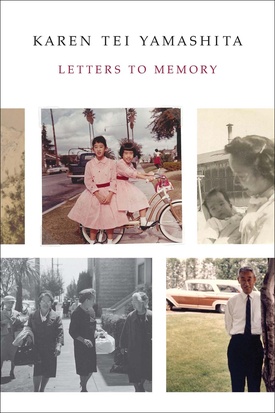In his insightful Sept. 13, 2017 Christian Science Monitor review of Karen Tei Yamashita’s Letters to Memory, Terry Hong concluded with this appraisal: “Allusive, quirky, questioning, Letters is a challenging text . . . dense with assumptions of cultural literacy, community insight, historical background. . . . (However) don’t be deterred (as) Letters awaits your inquisitive participation and rewarding collaboration.” My own initial reading of this brilliant book, whose form and content reached well beyond my grasp, inclined me toward affirming Hong’s assessment. Before reading it a second time, however, I decided to listen to an engaging and illuminating interview with Yamashita about her book. Because this experience was so helpful for me, I would suggest to prospective readers of Letters to Memory that before even tackling it the first time they might want to consider listening to this interview: “LARB Radio Hour: Karen Tei Yamashita’s “Letters to Memory”; Plus “Sylvia” by Leonard Michaels.”
This volume, which is a hybrid of a documentary, a memoir, and an epistolary novel, had its genesis in 1995 when one of the author’s four aunts from the Yamashita side of her family, Kay, passed away and left behind two folders of letters. One of these, consisting of personal correspondence, Karen Yamashita covertly appropriated, but did not seriously read, no less exploit, until the last of Kay’s six siblings had died in 2004. In time this led to the assembly of a sizeable Yamashita family archive of “hundreds of photographs and documents, pamphlets and paintings, homemade films and audiotapes and gramophone records, and diaries” (p. x).
Upon publication of Letters to Memory, this archive, housed in the Special Collections and Archives at the University of California, Santa Cruz’s McHenry Library, was posted online for access and use. Visiting this site will supply added value to your comprehension and appreciation of the book under review.
The heart of Letters to Memory is Yamashita’s profound journey of exploration into her family archive to discover the significance of the Japanese American World War II social disaster — not merely in relationship to herself, her family, and her ethnic-racial community, but also as a template for fathoming still more imponderable and overarching matters such as the lessons and limits of history, the character of charity, the challenge of forgiveness, the trauma of war, the quality of love, the power of death, the pain of poverty, the poignancy of memory, and the problem of evil.
The portion of this book that I found most daunting and (to be honest) somewhat off-putting was Yamashita’s series of epistolary conversations with assorted “muses” and their arcane texts to investigate the Japanese American incarceration and to greatly expand its meaning. However, I am painfully aware that this very dimension helps qualify Letters to Memory as a work of literary genius. The aspect of the book that most depressed me was the realization, shared by the author, that our country is now on the verge of reprising many of the “slings and arrows of outrageous fortune” that befell Nikkei during World War II onto different groups of demonized Americans. On the other hand, I am uplifted by the fact that Yamashita’s leitmotif in Letters to Memory is the necessity for us to resist oppression by committing ourselves to civil and human rights, democracy and social justice.
Letters to Memory
By Karen Tei Yamashita
(Minneapolis: Coffee House Press, 2017, 200 pp., $19.95, paperback)
* This article was originally published on The Nichi Bei Weekly on Juyly 19, 2018.
© 2018 Art Hansen / Nichi Bei Weekly








